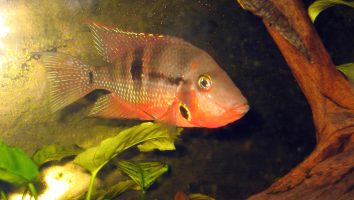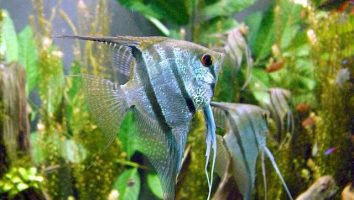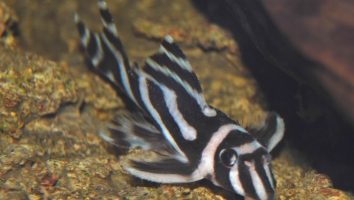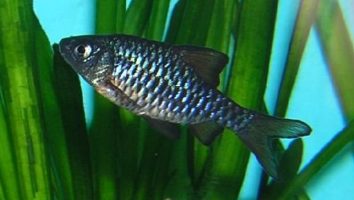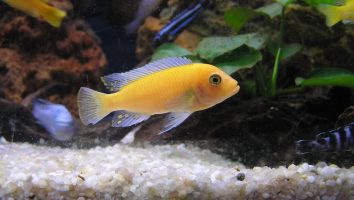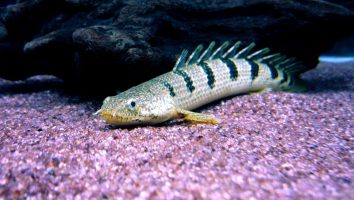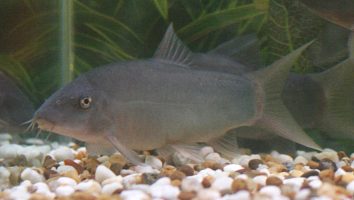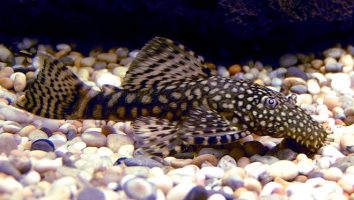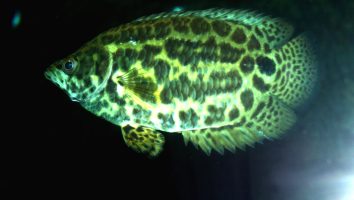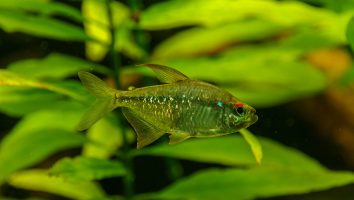The Royal Tetra (also known as the Regal Tetra or the Golden Tetra) is an absolutely stunning freshwater fish.
This species is very popular among fishkeepers because of its unique coloration and peaceful nature.
But even though they’re popular, there’s still a lot of misinformation out there about them. We’ve seen all sorts of conflicting information on care, tank mates, and more.
So we made this guide to set the record straight. In it, you’ll learn everything you need to know about Royal Tetra care. From diet and tank size, to lifespan and tank mates. It’s all here!
Table of contents
Species overview
Royal tetras (scientific name: Characidae) are a freshwater fish that’s native to the Orinoco River basin in South America.
They’re a social fish that likes to live in groups, so it’s best to keep at least six of them together. Royal tetras are also peaceful fish, so they make a good addition to community tanks.
These fish are relatively small, only growing to be about two inches long. Despite their small size, they have a voracious appetite and will eat just about anything.
The royal tetra is a very popular aquarium fish because of its bright coloration. The body is a deep blue color with a bright red stripe running down the middle. This coloration is what gives the fish its name, as it resembles a royal crown.
Appearance

The Royal tetra is a very elegant and colorful freshwater fish. They’re one of the smaller tetra species out there and only grow to be about 2.5 inches (6.4 cm) long.
The base color of the Royal tetra is a beautiful bluish-silver. This color is broken up by a thick black horizontal stripe that runs along their flanks.
This stripe is widest right behind their head and then tapers off as it goes towards their tail. Underneath this stripe is a thinner line of iridescent blue.
The Royal tetra also has a bright red patch on their caudal peduncle (the area right before their tail fin). This patch is bordered by a thin line of blue.
The fins on the Royal tetra are mostly clear with a little bit of black along the edges. The dorsal and anal fins are both slightly rounded and of medium size.
The caudal fin is forked and slightly longer than the other fins. The ventral fins are very small and sit close to their anal fin.
Lifespan
Royal tetras have a lifespan of 3 to 5 years. As with most fish, their lifespan can be affected by a variety of factors.
One thing that really stands out is their diet. Royal tetras are very sensitive to water quality and will not do well in an environment with poor water quality.
Another thing to keep in mind is that these fish are very sensitive to changes in their environment. Even something as small as a change in the temperature of the water can cause stress, which can shorten their lifespan.
Size
The adult size of a Royal Tetra is only around 2.5 inches in length. These fish are relatively small, so they don’t need a ton of space to swim around.
Tank
Tank Size
The minimum tank size for a Royal tetra is 10 gallons. This is assuming you’re keeping them in a school of at least 5 or 6 fish (which you should).
We personally recommend a slightly larger tank if you can accommodate it. Every extra space will make a big difference and allow you to keep a larger school or more tank mates if you’re interested in a community tank.
Water Parameters
The royal tetra (also called the diamond tetra) is a freshwater fish that’s native to the Amazon Basin in South America.
This makes them a warm water fish that does best in water that’s between 70 and 80 degrees Fahrenheit.
The royal tetra is also a bit more sensitive to changes in water parameters than some other freshwater fish. So, it’s important to keep a close eye on things like pH levels and nitrate levels.
Here are a few basic water parameters to help create a healthy environment for your royal tetras.
- Water temperature: 70 to 80 degrees Fahrenheit
- pH levels: 6.0 to 7.5
- Water hardness: 2 to 12 dGH
- Alkalinity Levels: 4-8 dKH
What To Put In Their Tank
The royal tetra is a small freshwater fish that’s native to South America. They’re a peaceful species that’s known for their vibrant colors and easy care.
In the wild, these fish can be found in slow-moving rivers and streams. They’re not a demanding species when it comes to their habitat, which makes them a great choice for beginner aquarists.
When setting up a tank for royal tetras we recommend using a sandy substrate. This will help reduce the chances of them hurting themselves if they decide to start digging (which they’re known to do).
As for plants, these fish are not going to bother them too much. You can include some if you want, but there’s a good chance they’ll end up being uprooted. If you do go this route we recommend using something that’s anchored down well or can bounce back easily (like java moss).
In terms of decoration, these fish prefer a tank that’s on the more sparse side. A few pieces of driftwood or some rocks will do. Just avoid anything too big or small that they could potentially hurt themselves on.
Common Diseases
Royal tetras are a freshwater species of fish that are native to South America. They’re a popular choice for beginner aquariums because of their peaceful nature and stunning colors.
While they’re not particularly susceptible to disease, there are still a few illnesses that you should be aware of.
The most common disease that affects royal tetras is ich. This is a parasitic infection that manifests itself as white spots on the body of the fish.
If left untreated, ich can be fatal. However, it’s relatively easy to treat if you catch it early. The most common treatment is to raise the temperature of the water, which will speed up the life cycle of the parasite and allow the fish to fight it off.
Another disease to be aware of is velvet. This is a parasitic infection that is similar to ich, but the parasites are much smaller. This makes it more difficult to spot, but the treatment is the same.
As with ich, the most common treatment for velvet is to raise the temperature of the water. This will again speed up the life cycle of the parasite and allow the fish to fight it off.
Behavior & Temperament
Royal tetras are very peaceful fish that do best in groups. In the wild, they can be found in schools of hundreds of fish, so it’s important to keep them in groups in captivity.
These fish are relatively active and love to swim around. They’re not shy, so they’ll often be the first fish to come out and explore their environment. Royal tetras are also known for being very curious, so don’t be surprised if they start investigating you when you come to the tank!
Although they’re not aggressive, royal tetras can be nippy. They may nibble on the fins of their tank mates, so it’s important to keep an eye on them. They’re also known to eat smaller fish, so be careful when adding them to a tank with other small fish.
Tank Mates
The Royal tetra is a schooling fish, which means it does best when kept in groups. In the wild, these fish can number in the hundreds.
While you don’t need to have that many in your home aquarium, you should aim for a group of at least six. This will help reduce stress and make them feel more comfortable.
As for compatible tank mates, there are plenty of options. Royal tetras are peaceful and get along well with other community fish.
Some of the best include:
- Neon Tetras
- Cardinal Tetras
- Rummy Nose Tetras
- Ember Tetras
- Black Neon Tetras
- Glowlight Tetras
- Harlequin Rasboras
Breeding
The royal tetra is a beautiful freshwater fish that is popular in the aquarium trade. These fish are relatively easy to breed in captivity, but there are a few things you need to know first.
The royal tetra is a member of the Characidae family, which contains over 700 different species of fish. This family includes popular fish like the neon tetra, black skirt tetra, and piranha.
The royal tetra is native to the Amazon Basin in South America. These fish inhabit slow-moving rivers and streams with plenty of vegetation.
In the wild, royal tetras typically grow to be about 2.5 inches long. However, captive specimens often max out at around 2 inches.
Royal tetras are easy to care for and make a great addition to any freshwater community tank. These fish are peaceful and get along well with other peaceful community fish.
One of the best things about royal tetras is that they are very easy to breed in captivity. In fact, these fish will often start breeding on their own without any intervention from the aquarist.
If you want to increase the chances of breeding, there are a few things you can do. First, it’s important to have a good ratio of males to females. A ratio of 2:1 is often recommended.
It’s also important to provide the fish with plenty of hiding places. Royal tetras like to feel secure, and a densely-planted tank will help to reduce their stress levels.
Finally, make sure to feed the fish a high-quality diet. A diet rich in live and frozen foods will help to bring out the best colors in these fish and increase the chances of breeding.
When the fish are ready to breed, the female will lay her eggs on a plant or piece of driftwood. The male will then fertilize the eggs.
Once the eggs are fertilized, the parents will typically abandon them. It’s important to remove the parents at this point, as they will likely eat the eggs.
The eggs will hatch in 24-48 hours, and the fry will be free-swimming a few days later. The fry can be fed baby brine shrimp or other live foods.
Conclusion
The Royal Tetra is an absolutely stunning freshwater fish that is perfect for any aquarium.
They’re not only beautiful, but they’re also very easy to take care of which makes them ideal for beginner fishkeepers.
While they’re peaceful fish, they do best when kept in groups so we recommend getting at least 6 of them.
We think you’ll love having these fish in your tank and we’re confident that you’ll be very happy with them!

